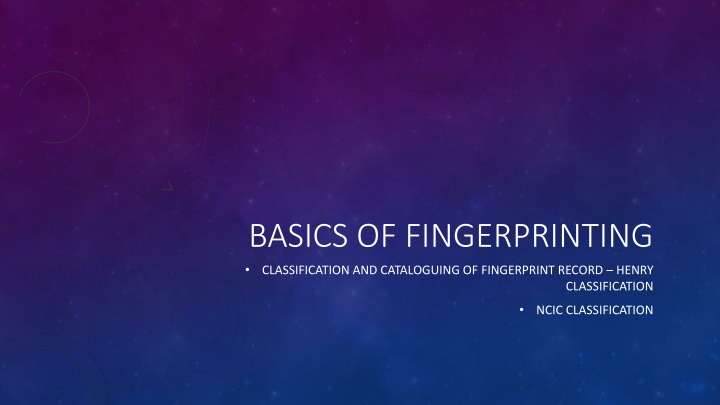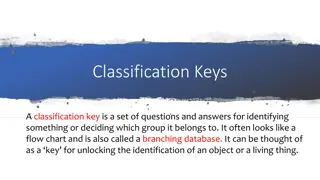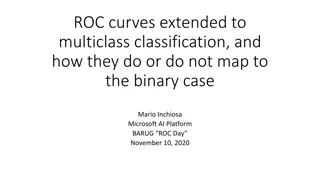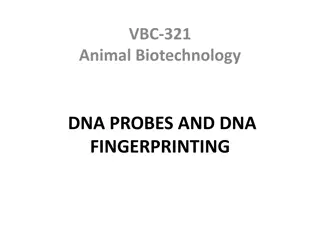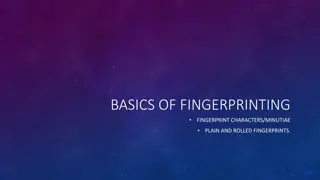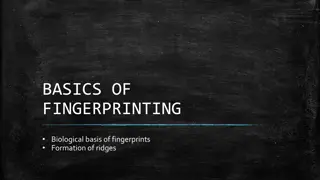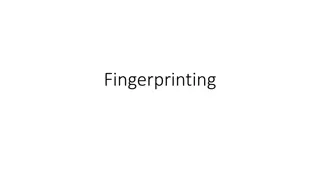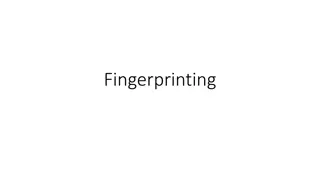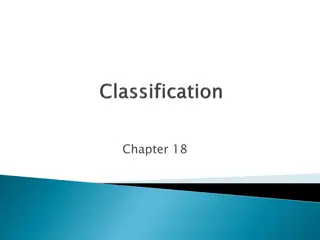Basics of Fingerprinting Classification and Cataloguing
Fingerprint classification is crucial in establishing a protocol for search, filing, and comparison purposes. It provides an orderly method to transition from general to specific details. Explore the Henry Classification system and the NCIC Classification, and understand why classification is pivotal in the realm of fingerprinting. Discover the components of the Henry Classification and the significance of primary and secondary classifications in fingerprint identification.
Download Presentation

Please find below an Image/Link to download the presentation.
The content on the website is provided AS IS for your information and personal use only. It may not be sold, licensed, or shared on other websites without obtaining consent from the author.If you encounter any issues during the download, it is possible that the publisher has removed the file from their server.
You are allowed to download the files provided on this website for personal or commercial use, subject to the condition that they are used lawfully. All files are the property of their respective owners.
The content on the website is provided AS IS for your information and personal use only. It may not be sold, licensed, or shared on other websites without obtaining consent from the author.
E N D
Presentation Transcript
BASICS OF FINGERPRINTING CLASSIFICATION AND CATALOGUING OF FINGERPRINT RECORD HENRY CLASSIFICATION NCIC CLASSIFICATION
WHY CLASSIFICATION IS REQUIRED To establish a set protocol for searching, filing, and comparison purposes. It provides an orderly method to go from the general to the specific.
HENRY CLASSIFICATION Classification system named after Sir Edward Henry. Originally consisted of four parts: primary, secondary, sub secondary, and final. Now includes an FBI (U.S. Federal Bureau of Investigation) extension, which changes the original configuration from four to six categories. ( major and little) After the introduction of technology and various automated fingerprint identification (AFIS) systems, this method has come to be known as the manual method.
CURRENT COMPONENTS OF HENRY Key: The ridge count of the first loop appearing on the card, excluding little fingers. Major: The ridge count or trace value of the thumbs. Primary: The numeric value of each finger containing a whorl pattern. Secondary: Capital letter indicating the pattern of index fingers. Sub secondary: Values of counts and traces of loops and whorls of the index, middle, and ring fingers. Final: Ridge count of loops appearing on the little fingers.
The known fingerprint card gives us the necessary information. Information is inserted onto the card aka blocking the card. Blocking the card consists of inserting the appropriate information consisting of numbers, letters, and symbols in the appropriate places on the card. layout and position of the fingers on the fingerprint card :
PRIMARY Numeric value of the finger where a whorl appears. Whatever finger the whorl appears on, that finger assumes the given value. Upon adding up the numbers, add 1 to the value. Even number fingers, 2, 4, 6, 8, and 10 are registered in numerator and Odd number fingers 1, 3, 5, 7, and 9 are registered in denominator. Numeric chart for primary If all fingers have ,primary classification will be 32 over 32. If no whorls appear on the card, primary classification will be 1 over 1.
SECONDARY Indicates the pattern type of the index fingers and is always indicated by a capital letter. A = arch T = tented arch R = radial loop W = whorl U = ulnar loop Registered as right hand over left hand on the classification line. Placed immediately to the right of the primary classification.
SUBSECONDARY Grouping of ridge count and/or whorl trace symbols for the index, middle, and ring fingerprints appearing on the card and it is indicated by letter. Right hand is indicated above the line, the left hand is indicated below the line. Placed to the immediate right of the secondary division on the card.
MAJOR Ridge count or ridge trace value of the thumbs, right hand over left hand. Designated immediately to the left of the primary. If there is an A or T in the thumbs, there will be no major classification. Whorl trace values will be indicated by inner (I), meet (M), or outer (O). Loop counts must be converted into small (S), medium (M), or large (L).
Always count the left thumb first. Based on the ridge count of the left thumb print, the right thumb designation can be determined based on the conversion chart. Left thumb conversion (For ridge counts) : 1 to 11 small (S) 12 to 16 medium (M) 17+ large (L) For Right thumb : Refer the chart. If a whorl appears in the left thumb print, use the smaller conversion chart to the right thumb.
FINAL Ridge count of a loop appearing in the little fingers. Right little finger is examined first to see the presence of loop. If there is no loop pattern in the right little finger, then the left little finger is examined. If neither the right nor the left little fingers possess a loop, there will be no final. Final can not consist of both fingers In large whorl sections, whorls can also be counted but this is rare.
KEY Ridge count of the first loop appearing on the card excluding the little fingers. The designation for the key is always indicated above the line farthest to the left on the classification.
CLASSIFY THE FOLLOWING AC. TO MODIFIED HENRY CLASSIFICATION WITH FBI EXTENSION
NCIC CLASSIFICATION National Crime Information Center Computerized system based in Washington, D.C. Uses twenty characters on a line. Each finger is represented by two characters.
IAFIS CLASSIFICATION Integrated Automated Fingerprint Identification System. Two characters per finger.
